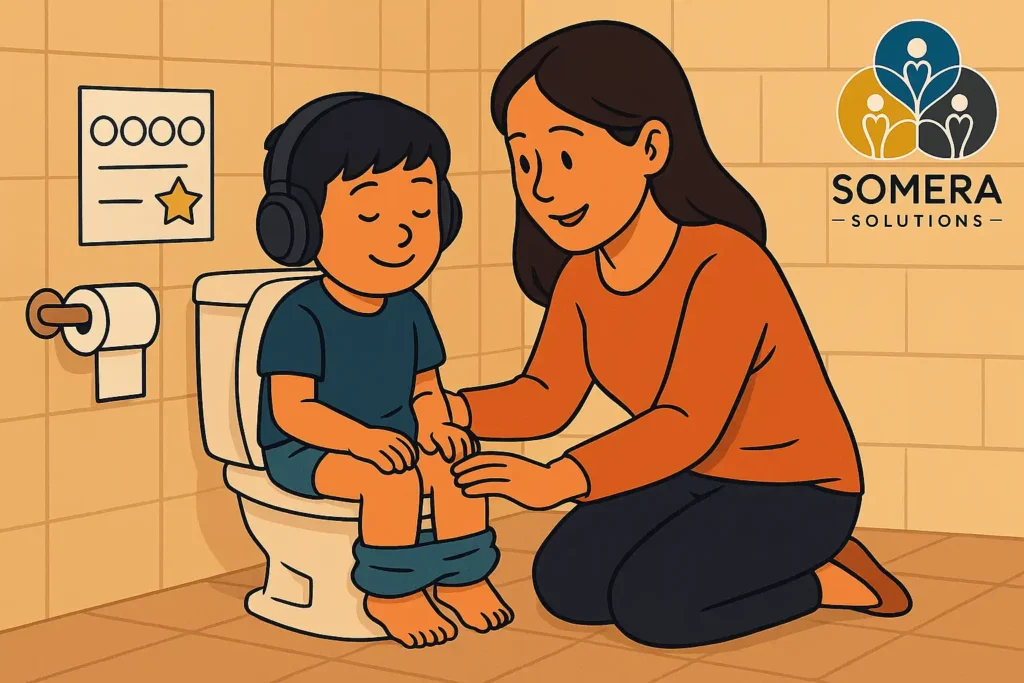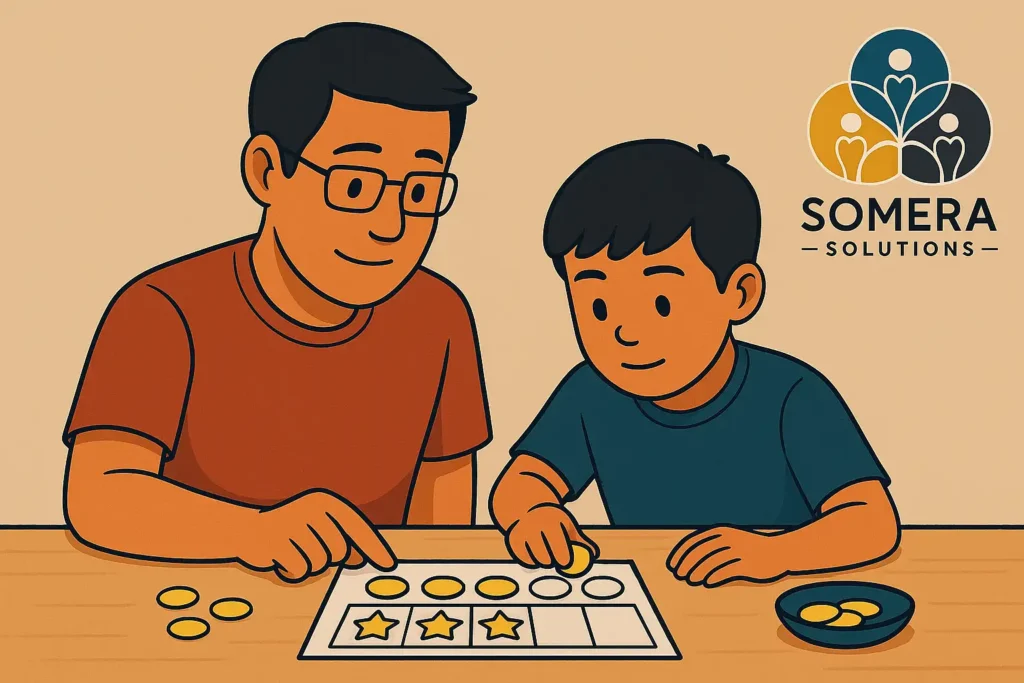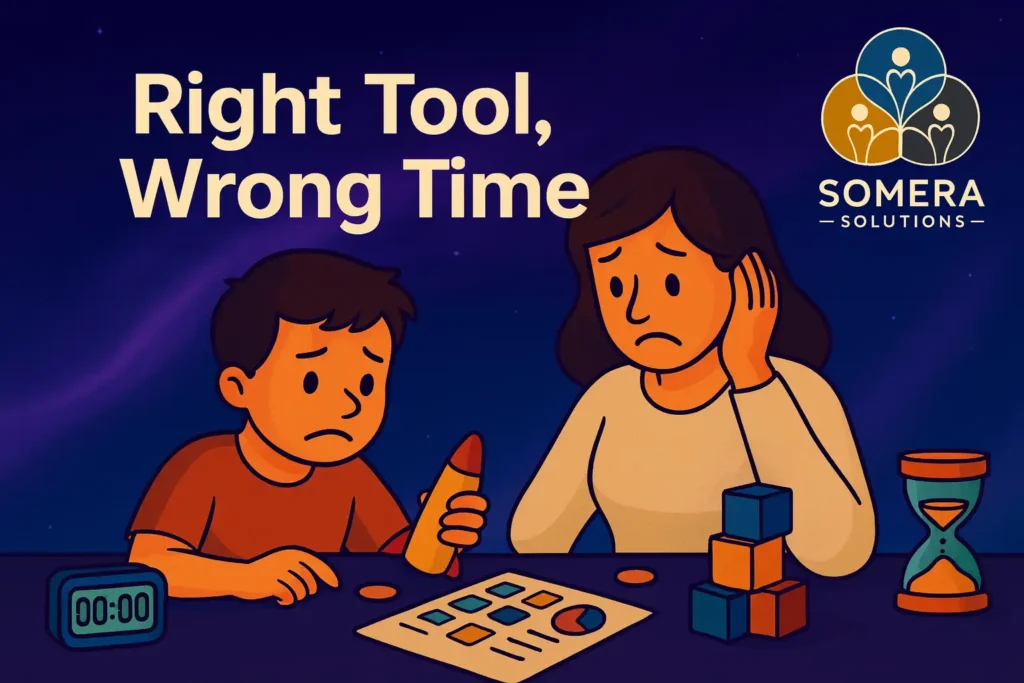3 Sensory Mistakes (And the Autism Resources to Fix Them)
More autism resources and gears, same meltdowns?
The problem usually isn’t your child. It’s the plan. Sensory tools are effective when they’re taught calmly, used proactively before the trigger, and tailored to the right need.
I love my child. I bought headphones, chewelry, fidgets, wobble seats, ankle weights… but the water dispenser still sends him running. My son also burns through toys fast, so I leaned into DIY—simple, cheap, easy to rotate. The real shift wasn’t the tool; it was how and when we used it.
Below are the three most common mistakes and small fixes using autism resources you can start today.
Mistake 1: Right Tool, Wrong Time
What happens: We reach for support after meltdowns or tantrums start (headphones once the toilet flushes, fidget when the line gets loud).
Why it fails: When a child is flooded, the “thinking brain” is offline. Tools feel like band-aids, not help.
Feeling stuck and don’t know what to do while waiting for a developmental assessment?
Fix With Autism Resources
- Plan it: Create a simple First–Then card: “First headphone, then flush.” Practice in a quiet room for 30–60 seconds, twice a day.
- Pre-load the tool: Headphones go on before entering the bathroom. Add a countdown (3–2–1—flush).
- Praise now: Token or sticker immediately for following the plan, not for “liking” the sound.
DIY support: Make a mini “Noise Plan” card (headphones icon + numbers 3-2-1). Tape it near the bathroom door. Keep a duplicate in your bag and add it to your autism and ADHD parenting resources that you can use.

One-minute routine:
Show card → 2) Headphones on → 3) Count down & flush → 4) Token + “Job well done!”
Why this works: You are pairing a predictable cue (visual + countdown) with a predictable support (headphones) before the sensory spike. Over time, the brain expects the sequence and stays more regulated.
Real-life example: We practiced the bathroom plan outside of potty time—10 seconds headphone on, 10 seconds off, praise. By day 4, my son walked in without headphones already on. The sound didn’t change; his readiness did.
Mistake 2: Tool Becomes A Crutch (No Skill Is Taught)
What happens: We rely on the tool to “fix” the moment, but don’t teach a portable self-calming skill.
Why it fails: When the tool isn’t available, the behavior returns.
Fix With Autism Resources
- Pair every tool with a skill:
- Breath script: “Silent blow, blow the bubbles”
- Body action: Press palms together, wall push-ups, or hand squeeze.
- Breath script: “Silent blow, blow the bubbles”
- Keep it visual: Draw a two-picture breath card (smell/blow). Practice when calm for 30–60 seconds, 2–3× daily.
- Use First–Then: “First blow, then open the bathroom door.”
DIY support: Index cards + marker = instant visual. Add a lanyard or clip for quick access.
Why this works: Tools regulate from the outside in; skills regulate from the inside out. Together, they generalize to any room, even without your favorite gadget.
Try this micro-practice (under 60 seconds):
Show breath card → 3 slow breaths → token now → move on.
Quick infomercial: My husband and I rebranded our small digital marketing agency and transformed it into an Autism, GDD and ADHD parenting resources hub. You can check our FREE resources here.
Mistake 3: Too Many Tools, No Plan
What happens: We keep buying new autism resources and tools and swapping daily. There’s no routine, no data, and novelty dies fast—especially for kids who get bored easily.
Why it fails: Nervous systems crave predictable supports, not a moving target.
Fix With Autism Resources
- Build a tiny sensory menu: Pick three tools to use for one week (e.g., headphones, chewy, hand fidget).
- Match the tool to the goal:
- Calm: breath card + wall push-ups
- Focus: hand fidget + visual timer
- Noise: headphones + countdown
- Calm: breath card + wall push-ups
- Teach outside the moment: 60-second practice, twice a day.
- Log wins: Note where/when it helped. Change one thing next week.
DIY Autism Resources That Last:
- Rice “lap sock”: Fill a long sock with dry rice, knot both ends—use during reading/meals.
- Calm jar: Plastic bottle + water + a bit of glitter glue—watch settle for 30–60 seconds.
- Chew option: Silicone pencil toppers or thick straws on a key ring.
- Quiet fidget tin: Two or three items only; rotate weekly.
- Timer hack: 1–3 minute kitchen timer; teach “play til the timer sound.” Add vocabulary phrases like “Time is up!”
Why this works: A small menu creates consistency (the brain relaxes) and variety by plan (boredom drops). You’re not guessing; you’re testing.
Align Tools With Autism Resources (So They Stick)
You don’t need everything online. Align three simple supports with real routines:
1) First–Then Visuals
- Bathroom: “First headphones, then flush.”
- Store: “First cart ride, then one aisle choice.”
- Practice cards in calm moments for 60 seconds.
2) Token Now, Tiny Trade Today

- Token for each step immediately (not end-of-day).
- Five tokens = pick the song, 3 minutes game time, choose the bedtime book.
3) Movement Before Hard Things
- 1–2 minutes: wall push-ups, carrying a book basket, animal walks.
- Then do the tough thing (bathroom, homework, checkout line).
A Simple 7-Day Plan (Less Gear, More Calm)
Day 1: Pick one hotspot (bathroom, store, hair washing). Make one First–Then card.
Day 2: Teach the tool when calm (headphones on/off + countdown) for 30–60 seconds.
Day 3: Add breath card (smell/blow) + body action (wall push-ups).
Day 4: Run the plan once in real life; keep it short; token right away.
Day 5: Build a sensory menu of three (headphones, fidget, breath card).
Day 6: Add one DIY item (rice sock, calm jar) during a calm block.
Day 7: Review your notes. Keep one win. Change one thing.
Kids who “burn through” toys need rotation by purpose, not panic. Swap one item weekly (not daily).
Create a parents template on how to review (2 minutes):
1. Circle wins (where it helped).
- Dot trouble spots (where it didn’t).
- Write one tweak for next week (e.g., “Move headphones to bathroom hook,”
- “Practice breath in the car”).
Small notes = steady gains.
Disclaimer: I’m not an expert. I’m just a mother who wants my son to get better using available ADHD parenting resources online. These methods, and the ones I will share in the future, are based on my experiences, research, webinars, and consultations with our pediatrician, developmental pediatrician, and therapists. For health development assessment and therapy planning, please consult a licensed practitioner.
Quick Checklist (Fridge-Ready)
- Tool on before trigger
- First–Then card posted
- 60–90 seconds move + calm first
- Token now, tiny trade today
- One-page plan shared with teacher/caregivers
Share the one-page plan: Add the visual steps, the three tools you’re testing, and the same cue words. This keeps adults aligned and helps your child hear one plan instead of five versions.
Troubleshooting (When It Still Feels Stuck)
- Refusal of the tool: Scale down. Try 10 seconds on, praise, off. Offer choice: “Headphones or bubbles first?” Celebrate any try.
- Tool throws: Respect the message—“too much.” Switch to body action (wall push-ups) and return later.
- New place, big reactions: Rehearse the plan in a similar space first (e.g., a quiet public restroom) before the busy mall.
- Scripting the plan: Keep lines short and rhythmic—the brain remembers rhythm. (“Headphones on, count to one—flush is done.”)
FAQ
Tools, services, and supports (visual schedules, OT/Speech, social stories, sensory aids, parent training) that make daily life easier and build skills at home, school, and in the community.
Send a one-page card: First–Then steps, your three tools, and the same cue words. Ask for a front-row seat, short directions, and brief movement breaks. Practice the plan at home so school isn’t the first try.
Connect first, make it visual (First–Then), add brief movement/breathing to regulate, and reward effort immediately; change one small thing each week.
One Last Thought
You don’t need plenty of autism resources. You need one calm plan you can repeat: teach when calm, use before the trigger, match tool to goal, praise fast. If you wonder why your child isn’t communicating or stops playing when you join, you’re not alone—it’s often a regulation and timing issue, not a love issue.
Our 14-Day Tuned-In Parenting ebook can help you build a communication plan between you and your child. In this ebook, you will take a test to identify your parenting role and style. Then, match it with your child’s communication phase.
Download it free and aim for the new mantra: Less gear. More plans. More calm.
Need a trusted developmental pediatrician?
Use the official PSDBP directory to search by name or region.
Note: If your doctor isn’t listed, they may still be a developmental pediatrician but not a member of the organization. Please verify independently.
Get tips, stories, and tools for raising neurodivergent kids.
Join our growing community of parents building hope with AI-powered support.
By submitting your email, you agree to receive updates, resources, and offers from Somera Solutions. You can unsubscribe at any time.
Iryne is a tech-savvy mama and the creative force behind Somera Solutions. With a background in engineering and technical writing, she blends her passion for AI, parenting, and early intervention to help families navigate autism, ADHD, and developmental delays, one tool at a time.


